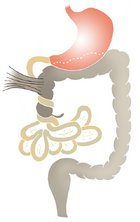Intestinal malrotation and volvulus
From WikiLectures
Malrotation means a malfunction in the rotation of the intestine or a malfunction in its attachment to the back wall of the abdomen. A normal intestine rotates counterclockwise. The superior mesenteric artery acts as the axis of rotation. An unfixed bowel predisposes to volvulus (knotting of the bowel hinge) and obstruction. It is sometimes associated with asplenism or congenital heart defects.
Clinical picture[edit | edit source]
- Symptoms of acute or recurrent Acute abdomen appear,
- symptoms are developed shortly after birth or anytime during the first year of life.
Diagnosis[edit | edit source]
- On the X-ray, we can see the distribution of air - there are no bubbles in the area of the caecum,
- rotation failure is then confirmed by irrigography.
Therapy[edit | edit source]
- Surgical
Links[edit | edit source]
Related articles[edit | edit source]
Sources[edit | edit source]
- BENEŠ, Jiří. Studijní materiály [online]. ©2007. [cit. 2010-04]. <http://www.jirben.wz.cz/>.
References[edit | edit source]
- HRODEK, Otto – VAVŘINEC, Jan, et al. Pediatrie. 1. edition. Praha : Galén, 2002. ISBN 80-7262-178-5.
- ŠAŠINKA, Miroslav – ŠAGÁT, Tibor – KOVÁCS, László. Pediatria. 2. edition. Bratislava. 2007. ISBN 978-80-89171-49-1.



